Beef roulades are a traditional German main dish. Learn how to make delicious roulades filled with onions, pickled cucumbers, and bacon.
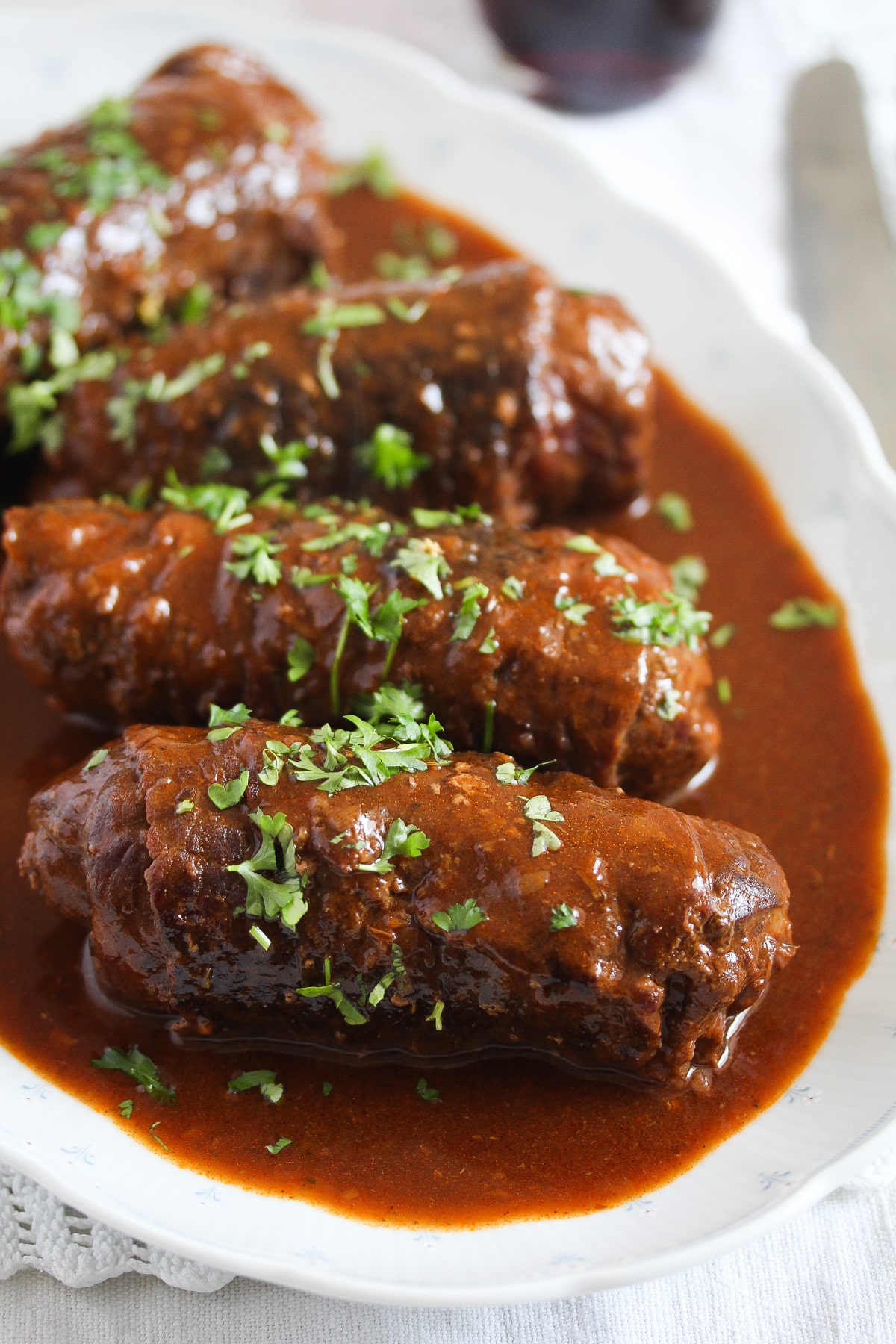
German beef roulades, or Rinderrouladen, are one of the most popular meals in Germany during the holidays. You'll often find them served at Christmas or Easter and maybe a few more times throughout the year. People often cook them on Sundays or when they have guests.
Check out more delicious dishes that are likely to be cooked or baked for guests: Stuffed Savoy Cabbage Rolls, Cheese and Leek Soup with Ground Meat, or Schwarzwälder Kirschtorte.
Jump to recipe
What are beef roulades?
Beef roulades are a typical German Sunday or festive main dish. They are pretty large and very thin pieces of beef smeared with mustard and filled with onions, bacon, and a little gherkin or pickled cucumber.
Everything is simmered in a delicious sauce and served with mashed potatoes and vegetables of choice. There can be hardly any dish more German than that (well, maybe Sauerbraten).
I had these for the first time at my mother-in-law's place, and it took me years until I finally decided to make my roulades. I've always thought it would be too much hassle to roll and cook the roulades, but once I finally cooked them, I realized they weren't that complicated.
You can buy already-cut roulades at the butcher's; all you have to do is fill and roll them, which isn't a big deal.
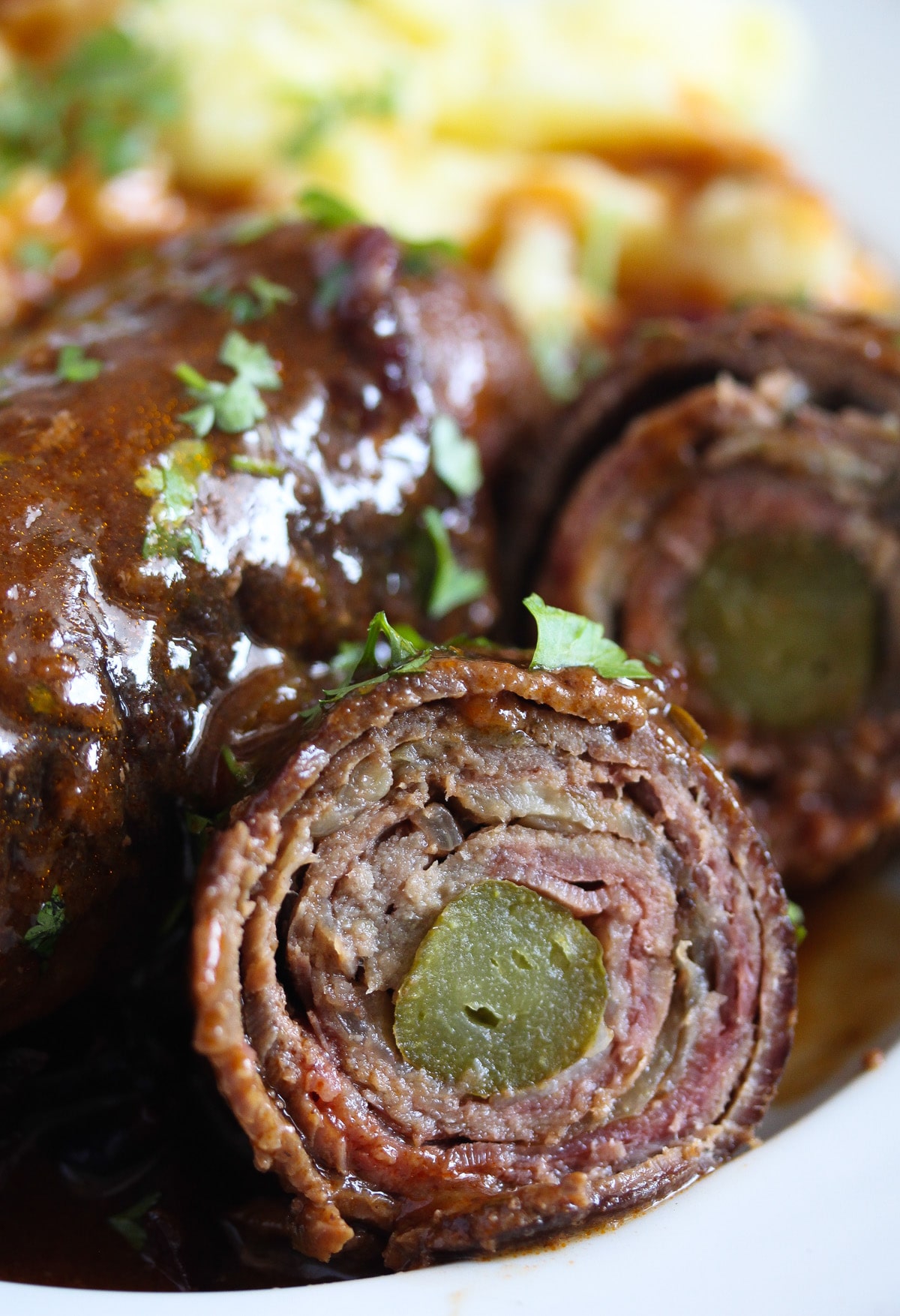
Recipe ingredients
Beef: If you live in Germany, buy Rouladen, which are thinly cut slices of beef meant to be turned into roulades. Otherwise, buy beef slices as thinly cut as possible; the best is to ask the butcher to cut them for you.
- A beef slice should be rather long, about 20-25 cm/ 8-10 inches, and about 10-11 cm /4-4.5 inches wide. It should weigh between 160 g - 200 g/ 5.6 - 7 oz each.
- You can use thin round steaks. Flatten them with a meat mallet; if not long enough, layer two to get the needed length.
Pickles: I used small, thin pickled cucumbers or gherkins. As you can see in the photographs, my cucumbers are very short, so I needed two for each roll.
Bacon: The bacon in Germany is super thin and super narrow. Narrow is not mandatory, but thin is. Use very thin bacon slices and one to three slices, depending on their width.
See the recipe card for full information on ingredients and quantities.
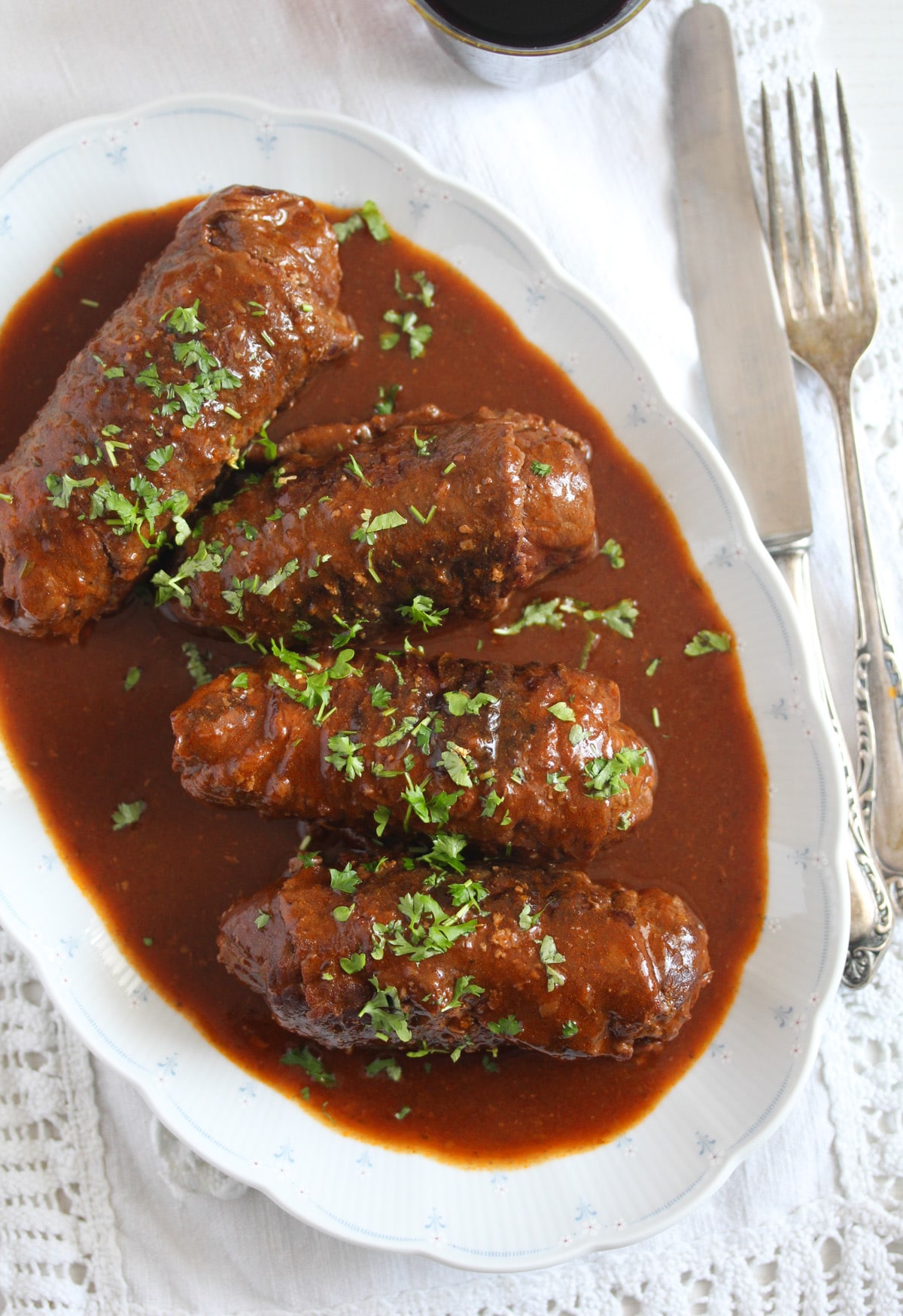
How to make German roulades?
Fill and roll the roulades
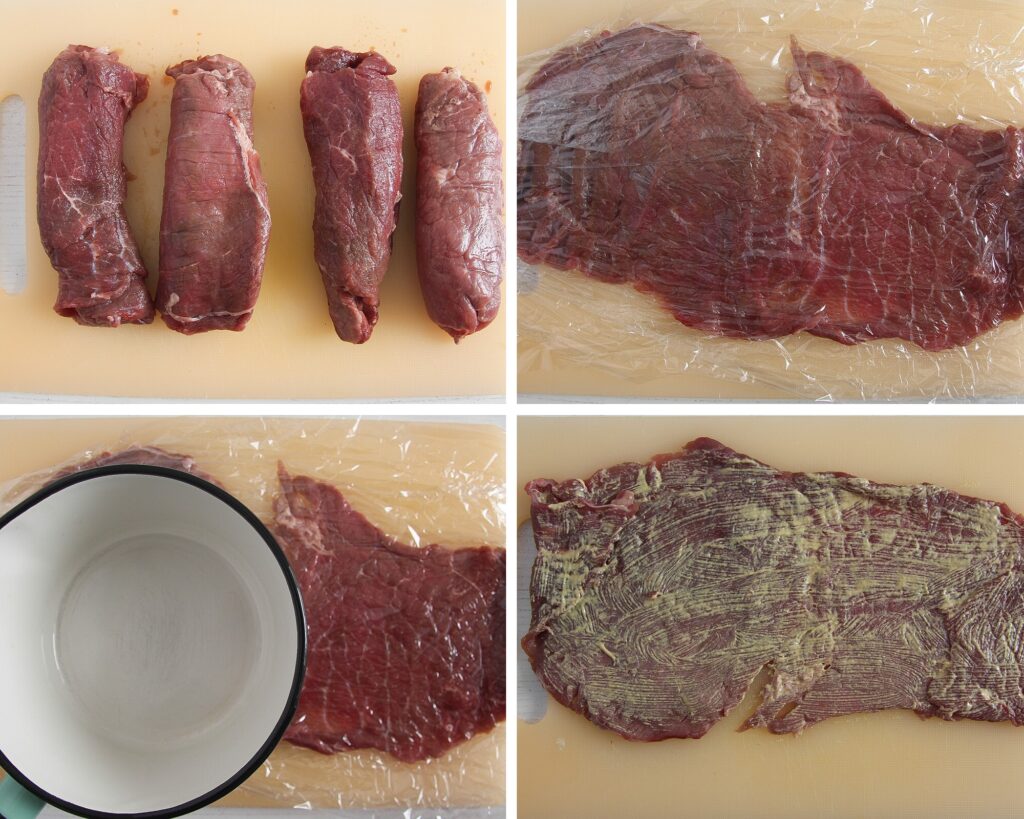
- Step #1: Unroll a beef slice on a cutting board.
- Step #2: Place the slices between lightly oiled pieces of plastic foil. This way, the meat won't stick to the mallet/saucepan, and there are fewer chances of bruising the meat.
- Step #3: Pound the meat until thin. Use a meat mallet or a smaller, heavy saucepan.
- Step #4: Smear the meat with mustard.
If you're using special Rouladen meat, you won't need to pound it for long - just two or three hits should be enough. If you're using slightly thicker slices, tenderize them until they are evenly thin.
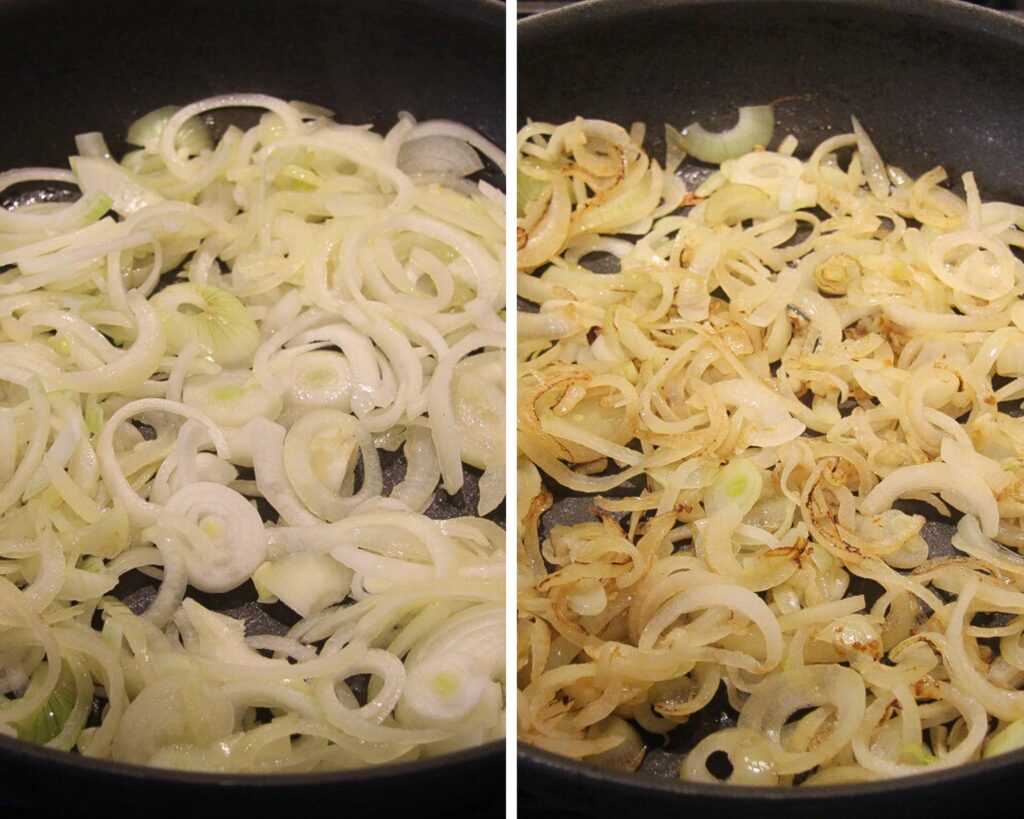
- Steps #5, 6: Cook the onions needed to fill the rolls; they will become sweeter and softer.
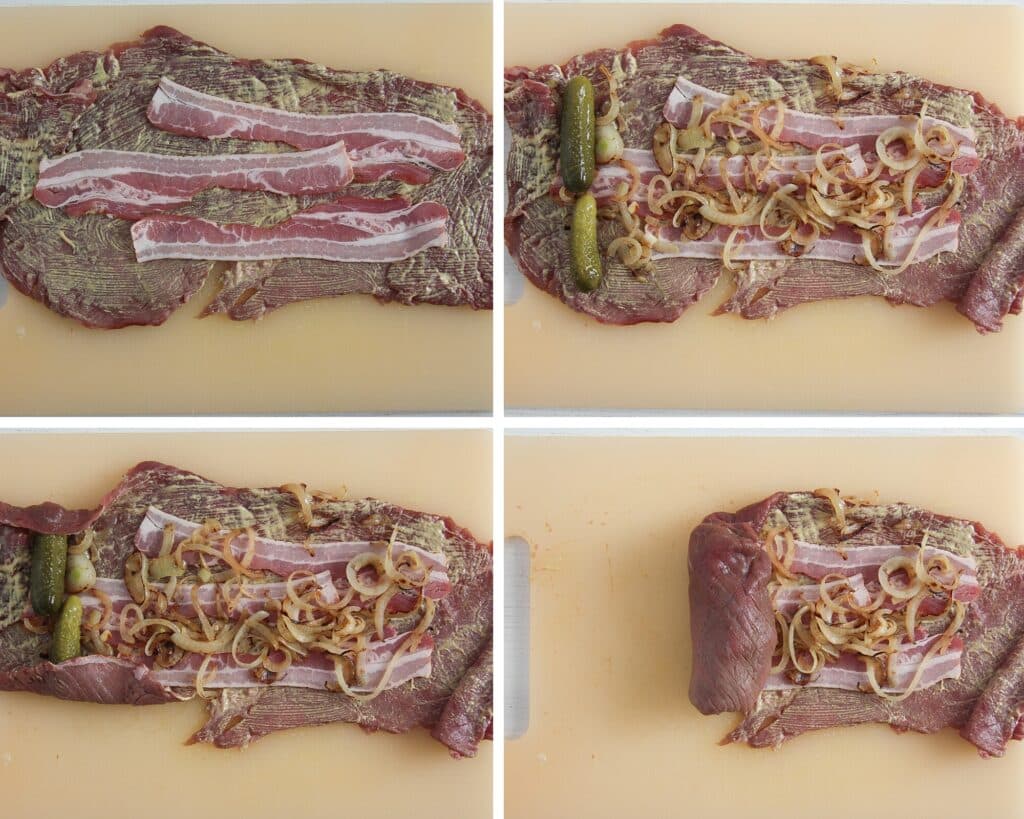
- Step #7: Lay the bacon slices on the meat slices.
- Step #8: Add the cucumbers and the cooked onions.
- Steps #9, 10: Fold the long sides of the beef slightly over the filling to keep it from spilling out.
Buy the thinnest pickled cucumbers you can find. If they are too short, use two for each meat roll.
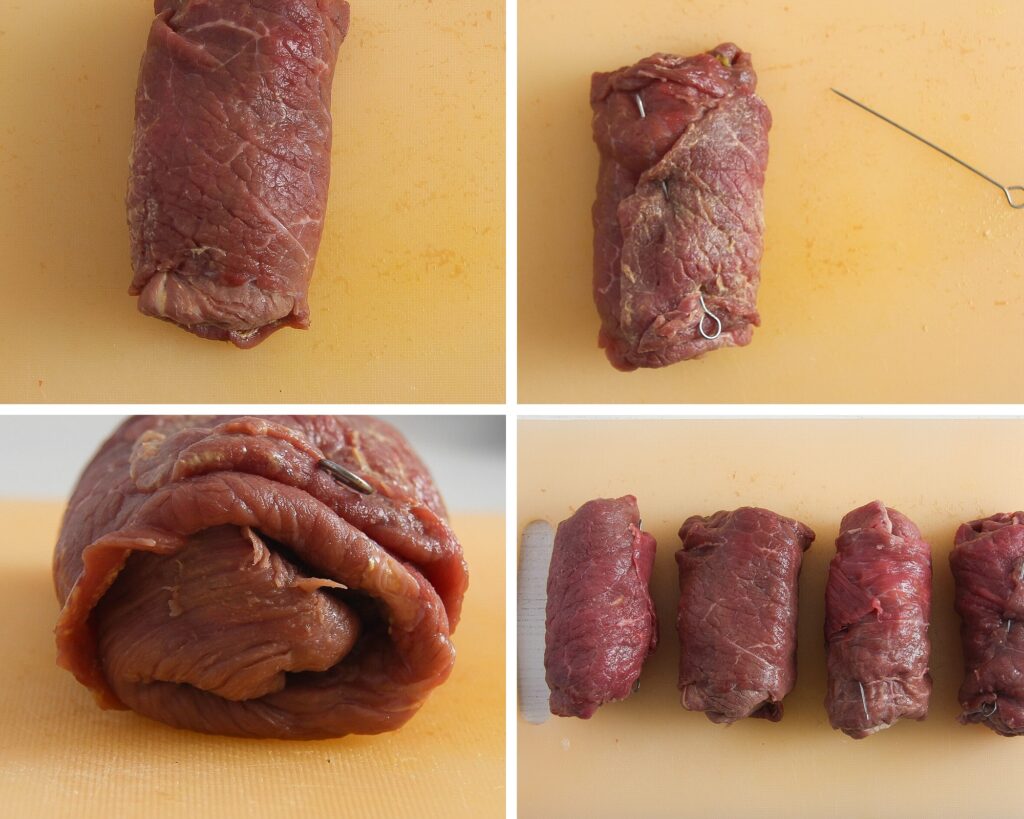
- Step #11: Roll the meat starting from the end with the cucumber.
- Steps #12, 13: Secure the roulades with a special roulade needle or use toothpicks.
- Step #14: Season with salt and pepper on all sides.
Make the sauce
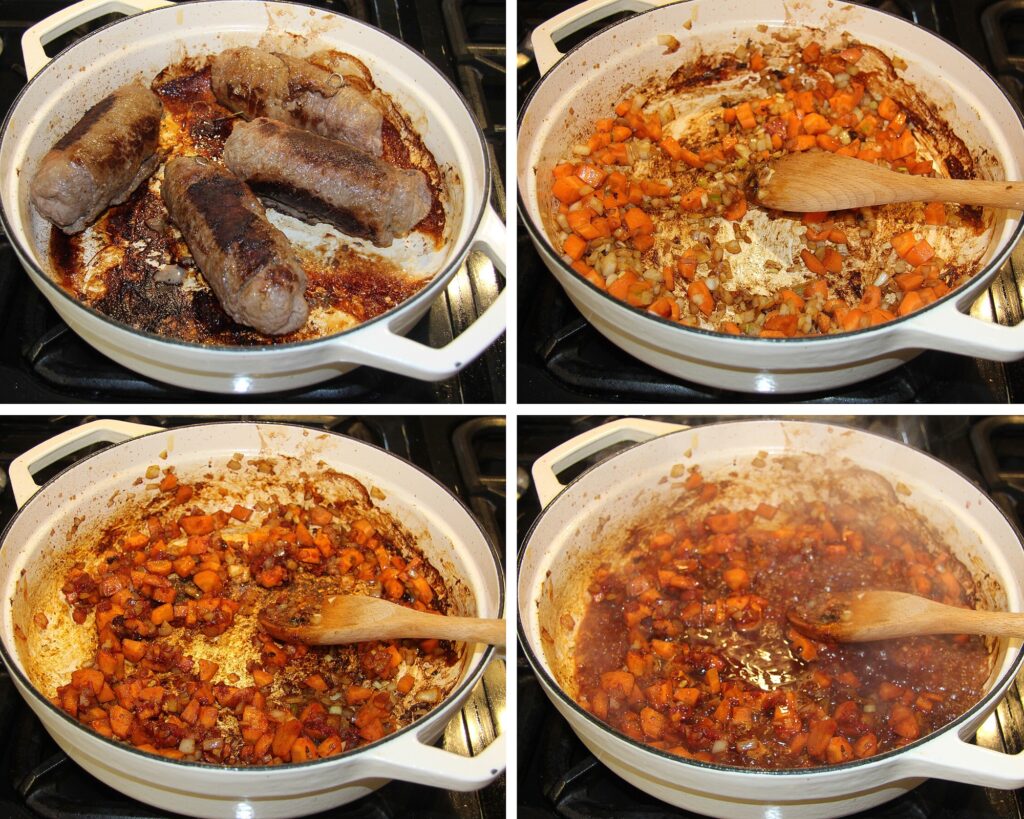
- Step #15: Brown the German roulades on all sides in a large Dutch oven. Remove them from the pot.
- Steps #16, 17: In the same pot, cook the onions and carrots until the onions are golden brown, about 5 minutes.
- Step #18: Add the tomato paste and sugar, cooking and stirring for a few minutes. Then, add the flour and continue stirring for another minute or two.
- Step #18: Add the red wine in 3 or 4 large splashes, allowing each to reduce before adding the next. Finally, add the last splash of wine, along with the beef broth and water, and bring everything to a boil.
You'll start with a lot of liquid: red wine, beef broth (or chicken stock), and water. While the sauce might initially seem abundant, it will reduce nicely as it cooks. Remove the lid during the last 15 minutes to help the liquid reduce.
Don't add too much salt at the beginning - just a pinch or none at all. If your beef broth is already salty, the sauce could end up too salty. It's better to check the seasoning at the end of cooking.
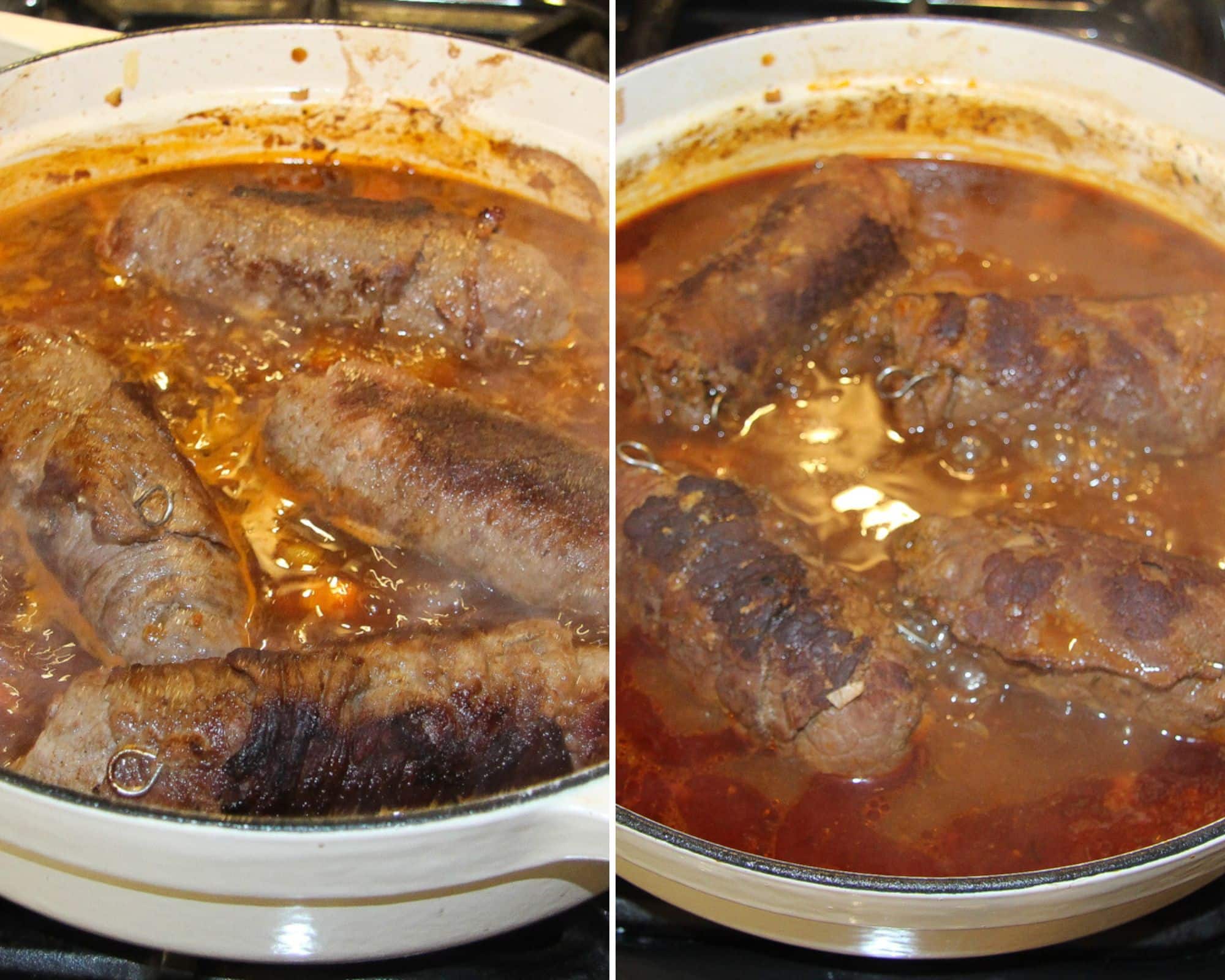
- Step #19: Add the meat rolls and simmer them for about 1 ¼ hour. Remove the lid during the last 15 minutes of cooking time to allow the sauce to reduce.
- Step #20: Remove them from the skillet and cook the sauce until it reaches the desired consistency; it will take about 10 minutes. Reheat the roulades in the sauce before serving.
If you prefer not to discard the vegetables, blend them into the sauce with an immersion blender. This will make the sauce taste great, but it will become opaque and quite thick.
For a glossy, smooth sauce, remove the vegetables with a slotted spoon and reduce the remaining sauce to your desired consistency.
You can also thicken the sauce with a cornstarch slurry if needed. Sometimes, I do that to speed things up, but allowing the sauce to reduce is finer.
Make in advance and store
You can make the beef roulades one day in advance and reheat them when ready to serve them. They are even better if you allow them to rest (in the refrigerator) for one day.
Refrigerate leftovers for 3-4 days or freeze them for up to 3 months. Defrost them in the fridge.
Reheat them on the stovetop, adding a splash of broth if necessary to loosen the sauce. You can also reheat individual portions in the microwave.
How to serve roulades?
As I mentioned above, this roulade recipe would make an ideal festive lunch for a special Sunday, Easter, or Christmas.
I love serving the rouladen with mashed potatoes, which are perfect for that hearty sauce. Plain boiled potatoes, which you can crush in the sauce, are fine as well. Try them with Rosemary Mashed Potatoes, for instance.
Another very traditional way of serving beef roulades is with Semmelknödel or German bread dumplings. You can buy them anywhere here, and they are great, but if you want to go the whole way, you can make your own.
Regarding the vegetable side dish, German red cabbage is just perfect; I think I usually serve the roulades with red cabbage. Otherwise, cauliflower, Brussels sprouts, or a mixture of carrots and peas are also good choices.

More German main dishes
Or check out the German main courses category.
Do you like this recipe?
Please leave a good rating in the recipe card below. Stay in touch through social media: Pinterest, Facebook, and Instagram. Don't forget to tag #whereismyspoon when you try a recipe!Recipe
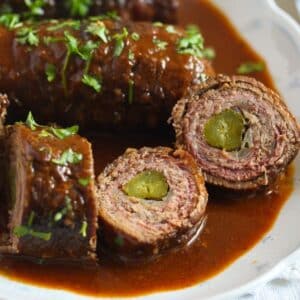
German Beef Roulades
Equipment
- Dutch oven or heavy-bottomed pot
Ingredients
Roulades:
- 4 thin beef slices /rouladen, Note
- 2 onions
- 1 tablespoon butter
- 4-8 small pickled cucumbers /gherkins, depending on size
- 2-3 teaspoons mustard medium
- 4-12 bacon slices very thin, depending on size
- fine sea salt and freshly ground black pepper
- some oil for brushing
Sauce:
- 2 onions
- 2 carrots
- 1 tablespoon oil
- 1 tablespoon tomato paste
- 1 teaspoon granulated sugar
- 1 tablespoon all-purpose flour
- 1 cup red wine
- 2 cups beef broth
- 1 cup water
- 1 large garlic clove
- 2-3 sprigs thyme
- fine sea salt and freshly ground black pepper
Instructions
Roulades:
- Tenderize meat: Cut two pieces of plastic foil larger than the roulades and brush them with a bit of oil. Lay the roulades one at a time on one of the plastic foil pieces, cover them with the second piece, and tenderize them using a flat object (I used a heavy saucepan with a handle; I "beat" the meat with the bottom of the saucepan). Set the beef slices aside. 4 thin beef slices + some oil for brushing
- Saute onions: Peel and halve them, then cut them into thin half circles. Melt the butter in a pan and cook the onions until nicely golden. Season with salt and pepper and leave them cool slightly.2 onions + 1 tablespoon butter + fine sea salt and freshly ground black pepper
- Fill: Brush each roulade with mustard. Place 1-3 very thin bacon pieces on the meat; it depends on how wide the bacon is (Note 2). Divide the onions into four portions and spread one part on each roulade. Place 1-2 small pickled cucumbers at the end of each beef slice.2-3 teaspoons mustard + 4-12 bacon slices + cooked onions + 4-8 small pickled cucumbers
- Roll: Fold the long sides of the beef just a little bit over the filling so that it would not come out. Roll the meat starting at the end where the cucumber lies. Fix the roulades by sticking them with a special roulade needle (if you have any) or with a toothpick. Sprinkle with salt and pepper on all sides.
Sauce:
- Chop the onions and carrots. Set them aside.2 onions + 2 carrots
- Brown: Heat the oil in a large skillet or Dutch oven. Brown the roulades on all sides, remove them from the pot, and set them aside.1 tablespoon oil
- Saute onions: Place the onions and the carrots in the same pot and cook until the onions are golden brown, about 5 minutes.
- Roux: Add the tomato paste and the sugar and cook, stirring, for a couple of minutes. Add the flour and continue cooking while stirring for another minute or two until the flour is slightly golden.1 tablespoon tomato paste + 1 teaspoon granulated sugar + 1 tablespoon all-purpose flour
- Add the red wine little by little (3 or 4 large splashes) and let it reduce before adding the following splash. Finally, add the last splash of wine, the beef broth, and the water, and bring everything to a boil.1 cup red wine/ 230 ml + 2 cups beef broth/ 460 ml + 1 cup water/ 230 ml
- Simmer: Place the roulades back into the Dutch oven with the finely chopped garlic clove and the thyme sprigs. Cover, turn the heat down, and simmer for about 1 ¼ hour. Remove the lid during the last 15 minutes of cooking time to allow the sauce to reduce.1 large garlic clove + 2-3 sprigs thyme
- Keep warm: Take the roulades out of the sauce, carefully remove the needles or toothpicks and keep them warm.
- Cook the sauce down for about 10 minutes. You can leave the vegetables inside and blend the sauce smooth, this will thicken the sauce, but the sauce will not be that fine anymore. For a finer sauce, remove the vegetables with a slotted spoon and reduce the sauce to the desired consistency.
- Taste and add salt, if necessary. It might not be; it depends on the saltiness of the beef broth. Add pepper.fine sea salt and freshly ground black pepper
- Reheat: Place the roulades back into the sauce and heat them again. Serve immediately as suggested above.
Notes
- Beef slices: A slice of beef should be rather long, about 20-25 cm/ 8-10 inches, about 10-11 cm /4-4.5 inches wide, weighing between 160 g - 200 g/ 5.6 - 7 oz each. You can use thin round steaks. Flatten them with a meat mallet; if they are not long enough, layer two to get the length you need.
- German bacon slices are very thin and narrow.

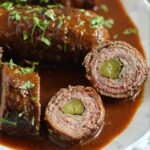
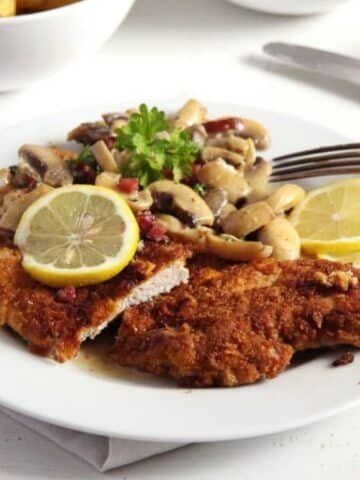
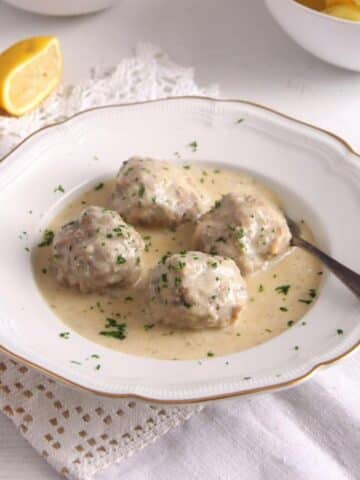
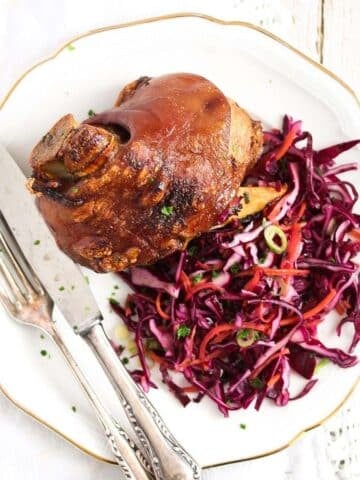
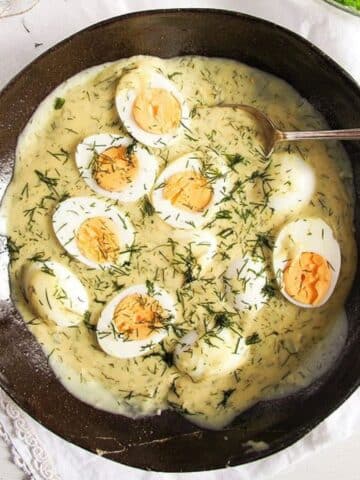
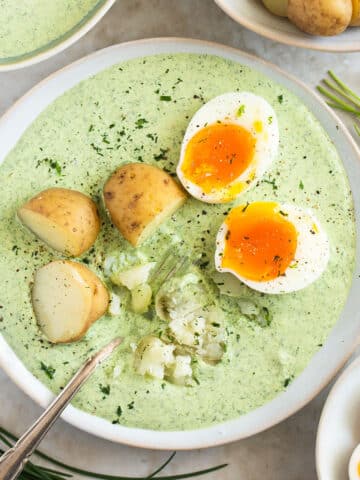
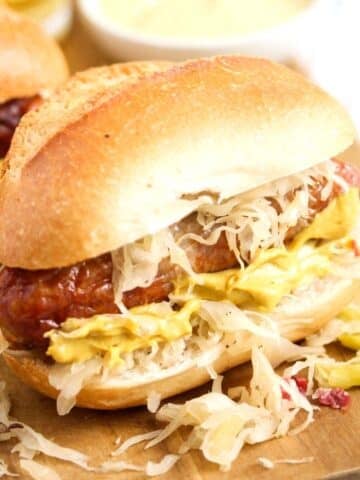
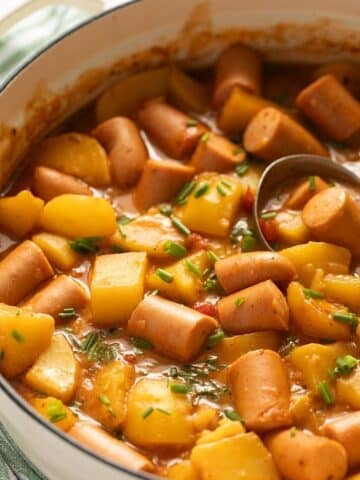
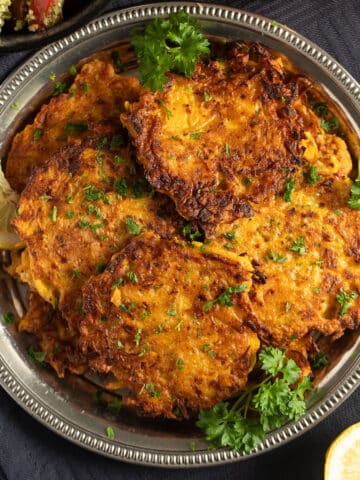

John says
Made according to the recipe and they are great. Used kosher dill pickles and tied with string
Susan says
There is no red wine, thyme, carrots, tomato paste or sugar in a traditional German Rouladen recipe . .. but I did add a bit of wine and it was a nice change.
Barbara says
My parents were German born and immigrated to the US in the 1930's. My mom made this since I was a child, which was long ago. Two things that are different about your recipe and hers is that she NEVER put pickles in it, I don't know why, and didn't cook the onions. I still make them her way, although I use the slow cooker instead of the stovetop, except to brown them. It is definitely a family favorite. I will try it with cooked onions, and see how we like that, but we are not big pickle fans, so I will still leave those out. I also find carne asada cuts are just the right thickness, sometimes a little short.
Adina says
Hi Barbara. Making them in the slow cooker sounds good, I will try it sometime. The pickles are nice, they add crunch and more flavor; they are quite typical here, but, of course, you can always leave them.
Pete wagner says
This is the perfect Rouladen recipe.. this was our traditional Christmas dinner..instead of toothpicks my grandmother used butchers twine to wrap the Rouladen , which is easy to do and keeps the wraps nice and tight when cooking .
RLaPerle says
This recipe turned out really great! It did take two of us to assemble and excute but worth the time. My husband had never tasted this but my mom used to make for us. Very tasty. Wanted to post a picture but I do not see an option?
Adina says
Hi. I am so happy to hear it! Sorry, I don't have an option for pictures. Thank you for the feedback!
Maria Weiss says
Great recipe I must try it
I will look for the German skewers
Adina says
Thank you, Maria. If you cannot find, toothpicks should be fine as well.
Valentina says
Hi Adina, I am wondering how this would work with chicken instead of beef?
Thank you!
Adina says
Hi Valentina. I've never cooked this with chicken. I can only say that chicken would need much less cooking time and therefore also less cooking liquid. It will also taste differently, quite another recipe. Let me know if you try it.
Kelsey says
This recipe was amazing. I am allergic to wheat, so I am on a gluten free diet. I used Bob Mill's Gluten Free All-Purpose Flour as a replacement and the Rouladen was still amazing!
Adina says
Thank you, Kelsey. I am some glad you liked it, they are delicious.
Adina says
Thank you, Rachel, I am sure you would like these. My plates are also an heirloom from my husband's grandmother. 🙂
Michelle Zohovetz says
This is similar to a dish my mother used to make but instead of mustard and pickle she used horseradish. It was delicious. I will have to try this next.
Rachel @ Simple Seasonal says
This recipe is awesome! I've never had anything like it before and I'm really intrigued. Your place setting is so elegant too!
Adina says
We don't eat much red meat either, once or twice a month I would say, but when then really good quality. I think you would like these. ?
Angie@Angie's Recipes says
Not really a fan of beef roulade, well, I generally don't eat red meat, but yours looks really tender and inviting, Adina.